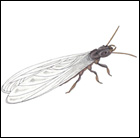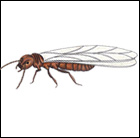Look Up There! Is That a Termite?
 When most homeowners hear the word termite, they usually think about the silent but very destructive subterranean termite. The subterranean termite, as its name suggests, invades structures from the soil beneath and will feast on a variety of wood, including framing, flooring and floor joists, deck posts, cabinets, and door frames.
When most homeowners hear the word termite, they usually think about the silent but very destructive subterranean termite. The subterranean termite, as its name suggests, invades structures from the soil beneath and will feast on a variety of wood, including framing, flooring and floor joists, deck posts, cabinets, and door frames.
The Clark Man has a long history of successfully treating and protecting homes from these destructive pests, which cost consumers nearly $5 billion annually for treatment and repair of the damage they cause. But did you know there is a termite that doesn’t like to get its antennae dirty?
The drywood termite – unlike its soil-loving cousin – lives above ground in the home’s wood siding, roofing, and wood supports in the attic. Drywood termites will swarm by the hundreds around the exterior of a home in search of the appropriate location to enter and begin their mischievous and destructive ways.
What areas of your home are at the greatest risk from drywood termites? In his experience, the Clark Man has noticed the following areas to be the most vulnerable to drywood termite infestation:
- Wood molding and framing around windows and doors
- Eaves and overhangs
- Protected joints or crevices in and around doors
- Attics and above-ground crawlspaces
- Wood siding and roofing
The fall of the year from September to November is prime drywood termite swarming season, and swarms most often occur on sunny days after a spike in the thermometer following cooler temperatures.
Drywood termites are deliberate in their actions, and will excavate a small tunnel into the wood, close it behind them, and create a chamber they will inhabit for a year or more. They can stay dormant for extended periods of time (more than a year) and then re-emerge stronger and hungrier than ever. And drywood termites are also creatures of habit and are known to re-infest the exact same place.
close it behind them, and create a chamber they will inhabit for a year or more. They can stay dormant for extended periods of time (more than a year) and then re-emerge stronger and hungrier than ever. And drywood termites are also creatures of habit and are known to re-infest the exact same place.
What are some signs that drywood termites may be targeting your home for their next dinner buffet?
- Large numbers of flying insects on the exterior (and sometimes on the interior) of your home that are focused on the wood
- Wings on windowsills, or flying termites on the exterior your home
- Hollow-sounding or visibly damaged wood that is honeycombed or carved out. If you can easily make a hole in the wood with a pocket knife or flat-blade screwdriver, it might be termite damage
- Unexplained piles of what looks like coarse grains of sand (these piles are termite fecal pellets sifted out of wood by the termites)
Remember, if you suspect your home has a problem with drywood termites, call 800/WE-NEED-YOU or drop me an email at clarkcares@clarkpest.com. Our highly trained, fully licensed termite inspectors will inspect your home thoroughly and, if treatment is required, will recommend preventative and curative treatments that are backed by our guarantee of 100-percent satisfaction.
Until next time, I’m the Clark Man, and thanks for helping me keep unwanted pests out of your home.


